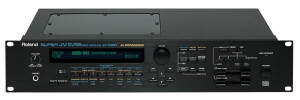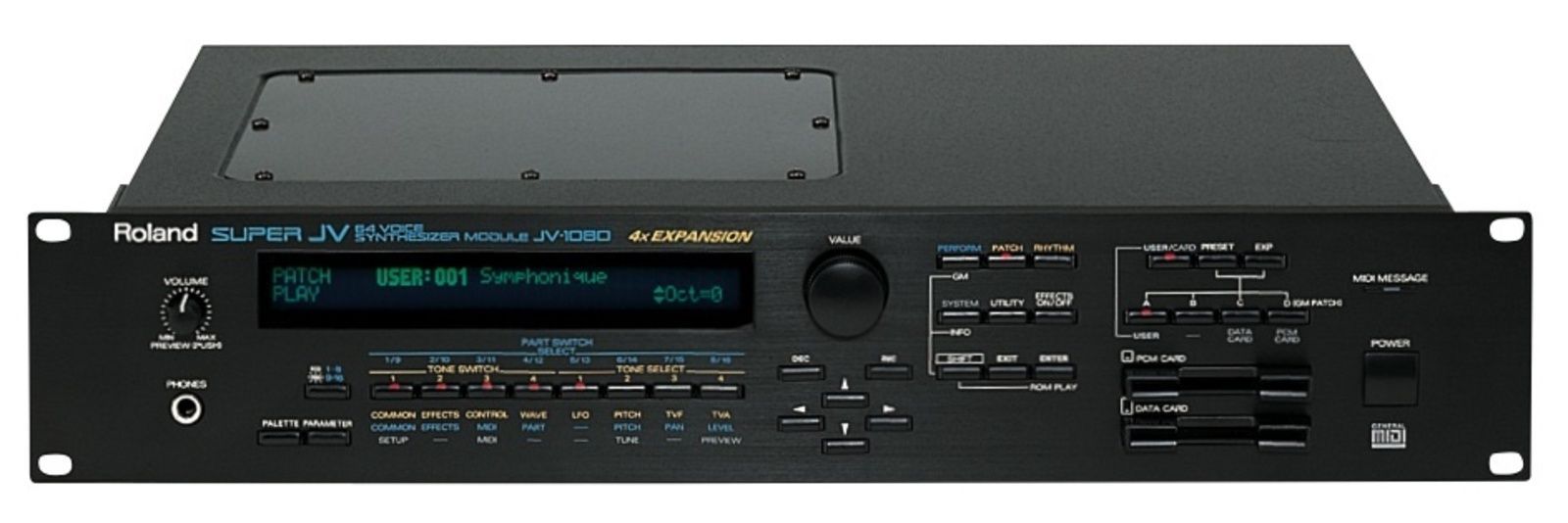View other reviews for this product:
« The standard sound »
Published on 06/16/11 at 12:49The JV is the 1080 classic of the 90s. Released in 94, this module is a continuation of JV 80 and would t the best-selling history of synthtiseurs and endangered consquence, all the sauces used. Down on a 32-bit RISC processor which Confre the era computing power Ingala is a little bote everything. It offers a synthse plutt conventional internal-based samples, with 64 notes polyphony comfortable, a 16-channel multitimbral and an effects section (common all channels). The module can Local Accommodations 4 expansion cards of the SR-JV SERIES shared by all instruments in the range: these cards can advantageously enhance the collection of internal sounds.
UTILIZATION
Archtype numrique module rack with a small screen and menus, JV 1080 trs is not easy. This is especially a problem to program your own sounds. In any case, the machine is easy to address plutt ds that we understand the principle gnral. By against, having rgulirement use the "Parameter" to change modes quickly s'avre agaant. Normment I use this button, so much so that on my JV 1080 it began showing signs of fatigue. A single line of 8 buttons supplmentaires would have been enough to make the edition less pnible but we believe that too c'tait coteux the manufacturer (which has also seen his copy with the JV 2080 ).
SOUNDS
The basic sounds of JV 1080 are not unusual today, but occasionally they can dpanner. However, and this is especially true that we have SR-JV card, you can get rich and compelling sounds by taking the time to program patches that are subtle and shuffled samples available. This wealth of ingredients for the base contributes significantly intrt of the machine.
Purists accuse him an engine and samples in 37 kHz while the JD SERIES knew dj work 44 khz, which is itself a regression (possibly in return for the polyphony and multitimbral leves for the era). Still, the sound of the JV is a perfectly usable quality. It was generally felt that trend be an asset for some plutt tablecloths and a weakness for sounds that are meant sharper.
There are a lot of JV DMOS available on the net to get an ide. I will propose here a complment on some patches of my own (some nanmoins bass Techno on the cards and Vintage Synths): Roland JV-1080 ( http://arts21.net/index.php/studio/76-rolandjv1080 )
OVERALL OPINION
The JV 1080 is the image of the same versatile product but consensual. In other words, it should be many uses DIFFERENT but really excels any of them. As a result, it has a practical ct bote tools but lacks a little charm, all the other modules in this vein have appeared subsequently. Nevertheless, the JV 1080 is the price o INTERESTED it can be found today. This is probably the most direct Manir to have Roland's "standard" door by hand. The balance sheet, despite a very attractive interface, I find myself often want to program as rsultats gnralement are rewarding. The addition of expansion cards provides a range trs rich and easy to ACCS.
UTILIZATION
Archtype numrique module rack with a small screen and menus, JV 1080 trs is not easy. This is especially a problem to program your own sounds. In any case, the machine is easy to address plutt ds that we understand the principle gnral. By against, having rgulirement use the "Parameter" to change modes quickly s'avre agaant. Normment I use this button, so much so that on my JV 1080 it began showing signs of fatigue. A single line of 8 buttons supplmentaires would have been enough to make the edition less pnible but we believe that too c'tait coteux the manufacturer (which has also seen his copy with the JV 2080 ).
SOUNDS
The basic sounds of JV 1080 are not unusual today, but occasionally they can dpanner. However, and this is especially true that we have SR-JV card, you can get rich and compelling sounds by taking the time to program patches that are subtle and shuffled samples available. This wealth of ingredients for the base contributes significantly intrt of the machine.
Purists accuse him an engine and samples in 37 kHz while the JD SERIES knew dj work 44 khz, which is itself a regression (possibly in return for the polyphony and multitimbral leves for the era). Still, the sound of the JV is a perfectly usable quality. It was generally felt that trend be an asset for some plutt tablecloths and a weakness for sounds that are meant sharper.
There are a lot of JV DMOS available on the net to get an ide. I will propose here a complment on some patches of my own (some nanmoins bass Techno on the cards and Vintage Synths): Roland JV-1080 ( http://arts21.net/index.php/studio/76-rolandjv1080 )
OVERALL OPINION
The JV 1080 is the image of the same versatile product but consensual. In other words, it should be many uses DIFFERENT but really excels any of them. As a result, it has a practical ct bote tools but lacks a little charm, all the other modules in this vein have appeared subsequently. Nevertheless, the JV 1080 is the price o INTERESTED it can be found today. This is probably the most direct Manir to have Roland's "standard" door by hand. The balance sheet, despite a very attractive interface, I find myself often want to program as rsultats gnralement are rewarding. The addition of expansion cards provides a range trs rich and easy to ACCS.




